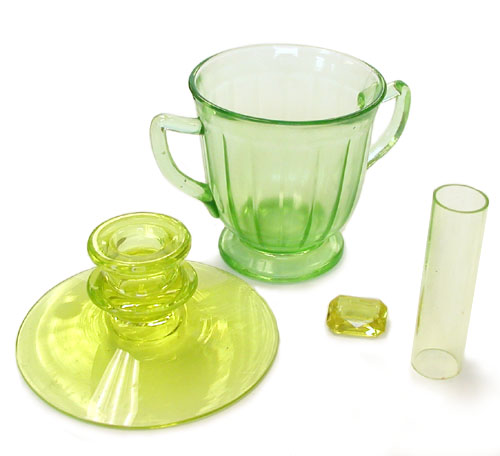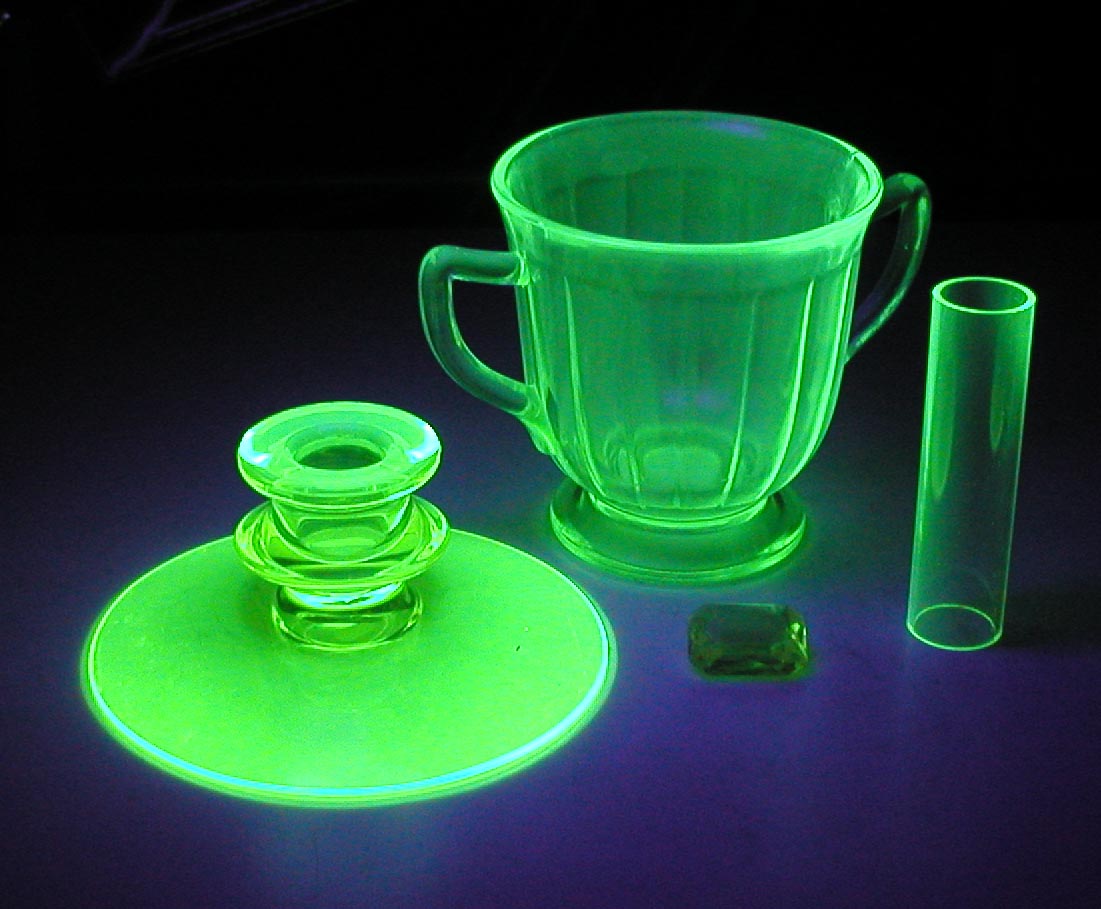Vaseline and Uranium Glass (ca. 1930s)

Vaseline glass, like the candlestick holder shown here, is a term for the transparent yellow to yellow-green glass that owes its color to its uranium content. Purists might argue that the green sugar bowl in the picture should not be considered Vaseline glass because an additional colorant (probably iron) has been used in addition to the uranium to produce the green. These cognoscenti might describe it as “Depression Glass,” a less desirable commodity.
Vaseline glass is a recent term that probably dates from the 1950s. Uranium glass, an older and more general term, is sometimes used as a synonym for Vaseline glass, but this can lead to confusion because some types of glass colored with uranium (e.g., custard glass and Burmese glass) are opaque whereas Vaseline glass is transparent. Canary glass is an even older name that was first used in the 1840s to describe what is now referred to as Vaseline glass.
Some transparent yellow or yellow-green glass has been colored using additives other than uranium (e.g., cerium oxide), and it can look exactly like Vaseline glass. To confuse matters somewhat, this non-Vaseline glass might even be radioactive due to the presence of thorium impurities!

Perhaps the most reliable way to identify the presence of uranium in the glass is to expose it in the dark to a source of ultraviolet light (e.g., a black light). If the glass glows a rich green color, it contains uranium. This green fluorescence explains why an example of Vaseline glass that looks yellow under incandescent lighting might take on a greenish tinge when viewed outdoors.
There are exceptions. Some uranium-containing glass does not fluoresce under ultraviolet light, e.g., the yellow glass "gemstone" does not fluoresce under UV despite the fact that it contains uranium!
An analysis indicates that all the pictured items contain natural uranium except the tube on the right which contains depleted uranium.
Production
Uranium was first used to color glass in the 1830s and it has continued to be used for this purpose with the exception of a fifteen year (or so) period beginning in World War II. Prior to World War II, natural uranium was used, but when Vaseline glass production resumed in 1959, the switch was made to depleted uranium (DU). All of the items shown here contain natural uranium except the tube on the right which contains depleted uranium. At present (2004), a few companies in the U.S. are still making Vaseline glass (e.g., Boyd Crystal Art Glass, Mosser, Summit Glass and Fenton Glass), but it is exclusively of the decorative variety. No dinnerware is being made.
Buckley et al (1980) estimated that there were at least 4,160,000 pieces of decorative uranium glass produced in the US between 1958 and 1978 and 15,000 drinking glasses from 1968 to 1972.
The uranium content of Vaseline glass is often on the order of 2% by weight. Nevertheless, the uranium content of some glass manufactured in the early 1900s, reached as high as 25%.
Estimates of the Radiation Exposures
A very detailed analysis of the radiation exposures due to uranium in glassware can be found in the Nuclear Regulatory Commission publication “Systematic Radiological Assessment of Exemptions for Source and Byproduct Materials” (NUREG 1717).
There are three principal radiation exposure pathways associated with Vaseline glass:
1. Exposure to the body from the gamma rays emitted by radionuclides in the glass.
Chemically processed uranium of the sort we are considering here consists of the following radionuclides: U-238, Th-234, Pa-234m, U-234, U-235 and Th-231. The principle gamma rays emitted by these nuclides would be 63 keV and 93 keV from Th-234 and 186 keV from U-235. NUREG-1717 estimated the following exposure rates from two different pieces of glass with 10% by weight uranium content:
| Distance | Drinking Glass | Decorative Piece |
|---|---|---|
| 1 foot | 9 x 10-4 mrem/hr | 1.8 x 10-3 mrem/hr |
| 3 feet | 1 x 10-4 mrem/hr | 2 x 10-4 mrem/hr |
| 6 feet | 2.5 x 10-5 mrem/hr | 5 x 10-5 mrem/hr |
For comparison, the background exposure rate due to gamma rays is approximately 1 x 10-2 mrem/hr.
2. Exposure to the hands from the beta particles emitted by radionuclides in the glass
The aforementioned NUREG-1717 also calculated the beta dose rates at a depth of 7 mg/cm2 (i.e., the nominal depth of the germinal layer of the skin) as well as the estimated effective dose equivalent. It was assumed that the source was a 10 inch diameter plate with a 10% by weight uranium content.
| Distance | Dose Rate | Effective Dose Equivalent Rate |
|---|---|---|
| Contact | 27 mrad/hr | 0.0027 mrem/hr |
| 1 foot | 1.1 mrad/hr | 0.0027 mrem/hr |
| 3 feet | 0.095 mrad/hr | 4.7 x 10-4 mrem/hr |
The ratio between the effective dose equivalent rate and dose rates vary with distance because the further away from the source, the greater the area of skin that was exposed.
3. Ingestion of uranium that has leached into food that has been in contact with the glass
Landa and Councell evaluated the leaching of uranium into different solutions over a 24 hour period. The glassware they used was designed to hold liquids (e.g., drinking glasses). They determined that the average resulting concentrations of uranium were 0.052 ug/liter (1.7 x 10-11 uCi/ml) for water and 5.9 ug/liter (2 x 10-9 uCi/ml) for acetic acid. The highest measured concentrations were 0.63 ug/liter (2.1 x 10-10 uCi/ml) in water and 30.1 ug/liter (1 x 10-8 uCi/ml) in acetic acid. They noted that less uranium would leach into solution when the experiment was repeated. The presumed explanation is that less and less leachable uranium becomes available.
After estimating the effective dose equivalents for a variety of potential exposure pathways, NUREG-1717 concluded that the highest doses would be to the personnel involved in the transportation of the glassware from a manufacturer to a truck distribution center. This maximum estimated dose, 4 mrem/year, is approximately 1 to 2% of the average American’s annual radiation exposure.
Pertinent Regulations
10 CFR 40.13 Unimportant quantities of source material.
(c) Any person is exempt from the regulation in this part and from the requirements for a license set forth in section 62 of the Act to the extent that such person receives, possesses, uses, or transfers:...
(2) Source material contained in the following products:... (iii) Glassware containing not more than 10 percent by weight source material; but not including commercially manufactured glass brick, pane glass, ceramic tile, or other glass or ceramic used in construction;
References
- Bloemendaal, S. Vaseline Glass Not Dangerous, But Addictive. New York- Pennsylvania Collector XXIV (7). September 2000.
- Buckley et al. Environmental Assessment of Consumer Products Containing Radioactive Material. Nuclear Regulatory Commission. NUREG/CR-1775. 1980.
- Landa, E. and Councell, T. Leaching of Uranium from Glass and Ceramic Foodware and Decorative Items. Health Physics 63 (3): 343-348; 1992.
- Nuclear Regulatory Commission. Systematic Radiological Assessment of Exemptions for Source and Byproduct Materials. NUREG 1717. June 2001.

A ‘glowing’ review of uranium glass
Did you know that uranium glass is the most viewed item in ORAU’s online Museum of Radiation and Radioactivity? With so many page views, we decided to divulge more information about these products. Whether you’re generally curious, are looking for information about uranium glass safety, or want to know the value of the glass you found at grandma’s house, we’ll try to cover the bases.
